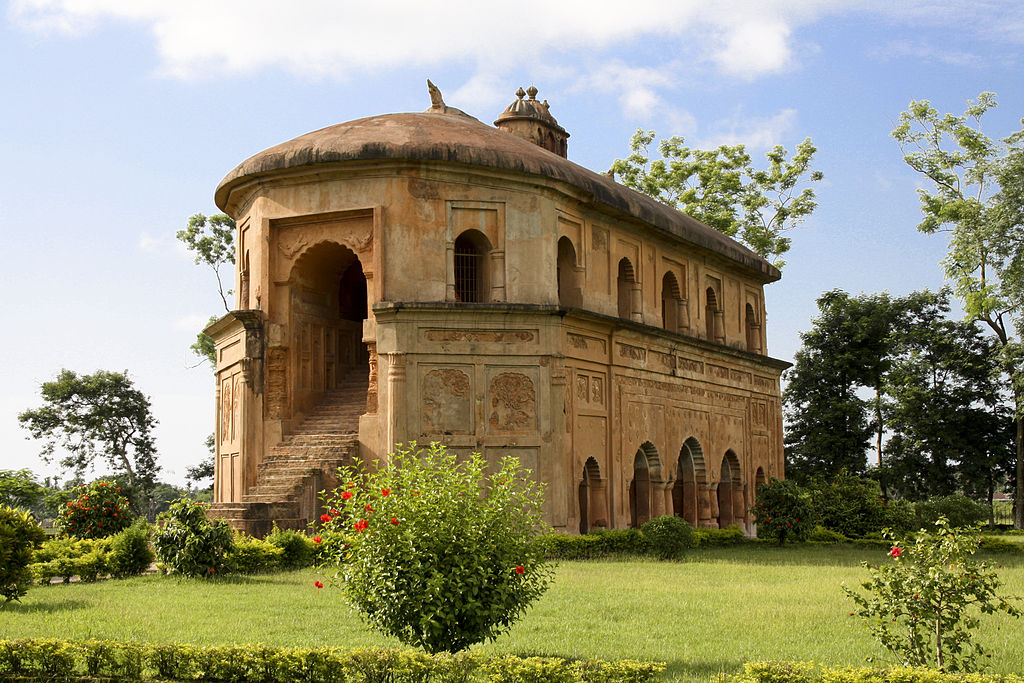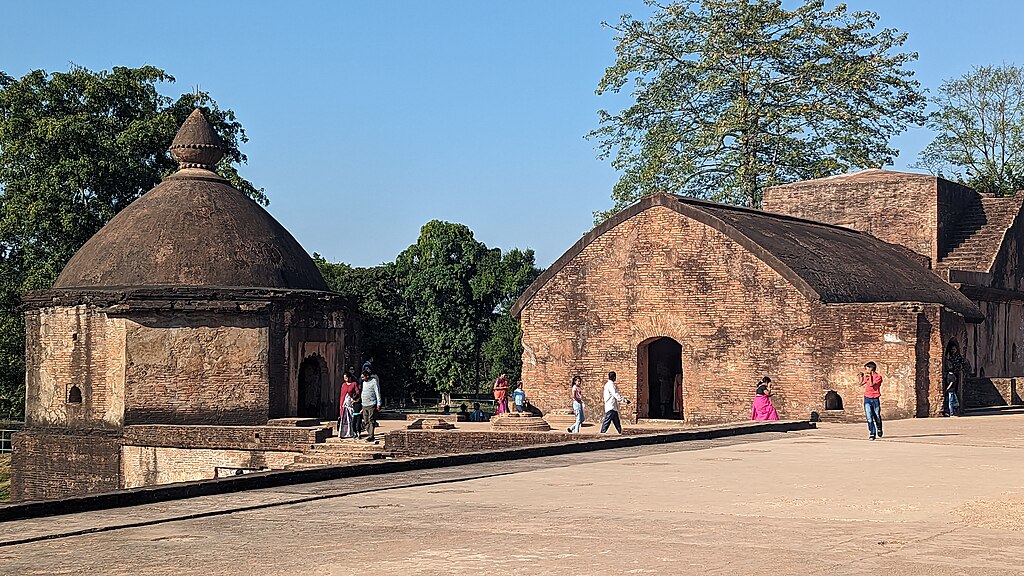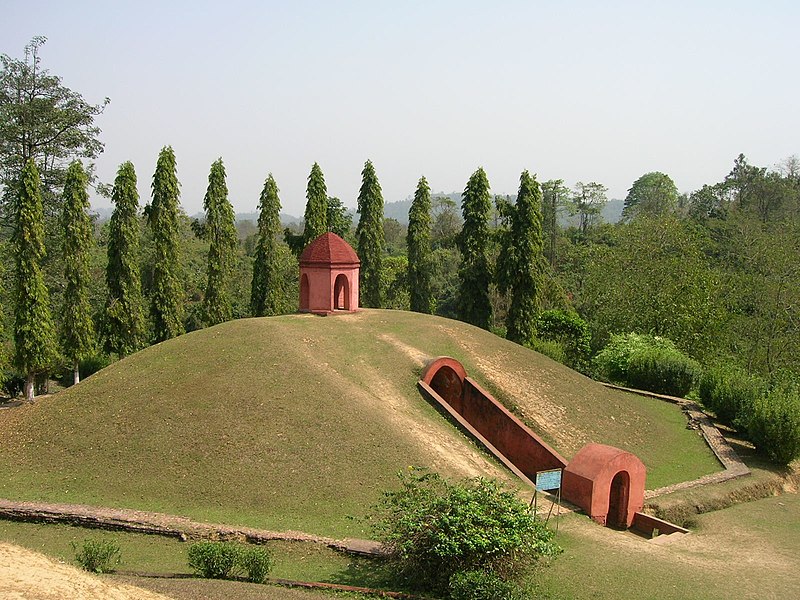Across the far depths of India’s nearly unending history, dynasties have risen and fallen. Many of them have left their mark on the subcontinent's past. And many have just been wiped off, without a trace or memory.
There are very few empires that can boast of a legacy as remarkable and enduring as the Ahom dynasty.
For over six centuries (1228-1826 CE), the Ahoms reigned supreme in Assam, carving a niche for themselves not just in the annals of history, but also in the hearts of the Assamese and Indian people. Apart from the Ahoms, the only 2 other dynasties that could boast of a similar reign were the Cholas and Palllavas of Southern India.
The empire that defeated the Mughals in the legendary Battle of Saraighat, defeating Aurangzeb’s armies. The empire that stood tall for an amazing 6 centuries!
Scattered across the landscapes of Assam, stand magnificent architectural monuments, silent testaments to the Ahom's engineering prowess, artistic vision, and unique cultural identity. These captivating structures serve as time capsules, transporting visitors back to a glorious era of power, innovation, and artistic expression.
Here are five stunning architectural marvels built by the Ahoms, offering a glimpse into the remarkable achievements of this bygone dynasty:
1. Rang Ghar, Sivasagar: A Stage for Royal Spectacles

The Rang Ghar was originally built by legendary King Swargadeo Rudra Singha in 1696 with bamboo, wood. It took 18 years to complete. However, the first structure did not survive long. Later, it was rebuilt in 1744 AD by King Swargadeo Pramatta Singha.
The Rang Ghar is the first amphitheater in all of Asia. This two-storied structure has an octagonal base, a distinctive feature that sets it apart from other monuments. The roof, a marvel of design, resembles an inverted Ahom royal longboat, a symbol of power and grandeur. Two "Makaras" or "Jalahastin" mythical aquatic elephant creatures, with their heads projecting outwards, adorn the roof, adding to the symbolic significance.
The Rang Ghar served as a central venue for a variety of cultural activities and sports enjoyed by both the royal families and the public. Witnessing dramatic performances, martial arts displays, and even animal fights likely filled the air with excitement during the Ahom era.
Though time has taken its toll, the remnants of arched entrances and the adjoining field, Rupohi Pothar, which translates to "silver field," speak volumes about the festivities that once unfolded here. These traces of the past transport visitors back to a time of revelry and competition.
The Rang Ghar's significance extends beyond its recreational purpose. It served as a platform for promoting and preserving Assamese cultural traditions. The games and performances held here likely spread throughout the Ahom kingdom and even influenced neighboring regions.
Located approximately 3 kilometers from the heart of Sivasagar town, on the Assam Trunk Road, the Rang Ghar continues to be a significant landmark. Today, it serves as a museum, showcasing artifacts that provide a glimpse into the Ahom era.
2. Shiva doul, Sivasagar: A Colossal Tribute to Lord Shiva
There are in fact 3 structures here: Shiva Doul, Vishnu Doul and Devi Doul. They are all located on the bank of the Sivasagar tank. These were built by Queen Ambika of the Ahom Dynasty in 1733-1734.
The centerpiece of the complex is the colossal Shiva doul temple, dedicated to Lord Shiva. This towering structure holds the distinction of being the tallest Shiva temple in Assam, one of the tallest in the world. Its imposing height of 180 feet and a width of 195 feet leave visitors awestruck.
The complex is a sprawling structure comprising a central sanctum, an elaborately carved gateway, and a towering vihara. The sanctum, the holiest part of the temple, houses the Shiva Linga, the symbolic representation of Lord Shiva. The entrance gateway boasts intricate carvings depicting scenes from Hindu mythology and floral motifs. The vihara, with its multi-storied structure, once served as a residence for monks and a place for religious gatherings.
Flanking the Shiva doul are two smaller temples, the Vishnu Doul dedicated to Lord Vishnu and the Devi Doul dedicated to Goddess Durga. These temples, also built by Queen Ambika in 1734 AD, echo the architectural style of the Shiva Doul.
3. Talatal Ghar

The Talatal Ghar, the largest monument built by the Tai-Ahoms, stands out with its unique seven-story structure. Three of these stories are built underground, forming the Talatal Ghar, while the remaining four stories that once rose above the ground, known as the Kareng Ghar. The Kareng ghar perhaps served as a royal residence. Today most of the upper floors are destroyed.
The construction of the Talatal Ghar was started during the reign of Swargadeo Rudra Singha in 1707. The initial construction utilized mostly semi-permanent materials. It was later enhanced with bricks in 1765 AD during the reign of Swargadeo Rajeswar Singha. This impressive palace served multiple purposes. It functioned as the royal court, administrative office, and even the strategic military headquarters of the Ahom kingdom.
Initially conceived as an army base, the Talatal Ghar incorporated features that suggest a strategic function. The complex housed two secret tunnels, believed to have been used as escape routes during conflicts. One tunnel, estimated to be roughly 3 kilometers long, is said to have connected the Talatal Ghar to the Dikhow River. An even more ambitious tunnel, stretching an alleged 16 kilometers, is thought to have led to the Garhgaon Palace, offering a potential escape route for royalty in times of danger.
The exposed upper stories offered separate spaces for different functions. The ground floor served practical purposes, housing stables, storage rooms, and living quarters for servants. The royal apartments were situated on the upper stories, though only a few remnants remain today
Beyond its internal layout, the Talatal Ghar was a fortified structure. A nearby Gola Ghar, a dedicated gunpowder and ammunition store, further underscores the strategic significance of the Talatal Ghar.
4. Kareng Ghar (Garhgaon):

Located in Garhgaon, the Kareng Ghar, also known as the Garhgaon Palace, stands as a majestic testament to Ahom architecture. This central administrative building once served as the heart of the Gargaon capital.
Originally constructed using wood, the palace underwent a significant transformation during the reign of Swargadeo Pramatta Singha. Seeking a more permanent structure, Swargadeo Rajeswar Singha commissioned the construction of the present-day Kareng Ghar. This impressive edifice, built using bricks and boulders, replaced the earlier wooden version and solidified the Kareng Ghar's position as a symbol of Ahom power and administrative prowess.
5. Charaideo Maidam

Located in Charaideo, the Maidams are a group of towering mausoleums dedicated to high-ranking Ahom officials known as Buragohains. These domed structures, built between the 16th and 18th centuries, stand as silent sentinels, commemorating the power and prestige of the Ahom nobility.
The size and grandeur of each mausoleum vary, reflecting the status of the official it commemorates. These structures serve as a tangible reminder of the respect Ahoms had for ancestors and the ones that passed away.
Today, the Maidam complex continues to be a significant historical site. The towering mausoleums stand as a testament to the Ahom dynasty's power and architectural prowess.
The architectural marvels of the Ahom dynasty stand as testaments to a bygone era. They narrate tales of innovation, pride, and brilliance. From the towering Shiva Doul to the enigmatic Talatal Ghar - each monument offers a glimpse into the remarkable engineering prowess and artistic vision of the Ahoms. They are an invitation to appreciate the enduring legacy of a kingdom that continues to captivate and inspire us today. So, on the next trip you plan, take a moment to step back in time and marvel at the grandeur of Ahom architecture.
(The author is a technologist and the Founder of Pathbeat.in, a web destination researching and promoting destinations across India)



